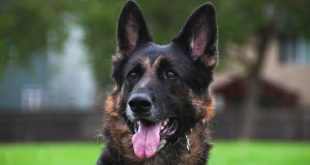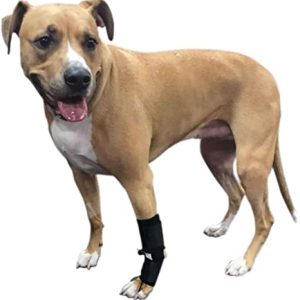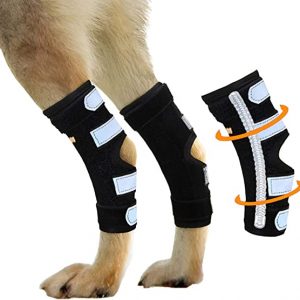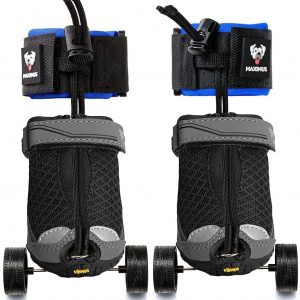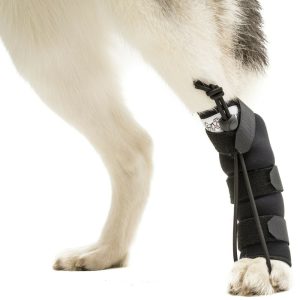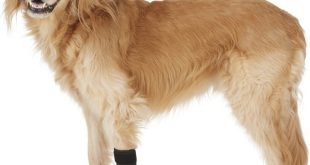Hey dog-dada/mama! Does the top of your fur baby’s paw drag along the ground as it walks? Or does it look like it’s trying to walk on the top of its paw rather than the bottom? Are any of its feet wobbly or crossing over as it walks? If any that applies to your dog, then quite possible your dog is suffering from Carpal laxity Syndrome. This condition is also commonly known as Knuckling!
If you want to know if your dog has condition, you should observe your dog while they are walking away and toward you and look out for any signs of unsteadiness or an uneven gait.
Also, you can determine if your dog is knuckling by having them stand and one at a time, lift their paws and place them down with their knuckle under…your pooch should immediately correct the position of their paw, and if they don’t it is likely that they are, for some reason, knuckling.
Of course, you’re aware this isn’t normal which is why you’re here, trying to find out what might be causing this, and what you can do.
So, let’s dive right into what might be wrong and how you can fix this problem to get your sweet pup all happy and running all around the place.
Table of Contents
- Why does knuckling occur? – Causes
- What to do if your Dog is Knuckling – Treatment
- How to prevent knuckling
- Extra advice
Why does knuckling occur? – Causes
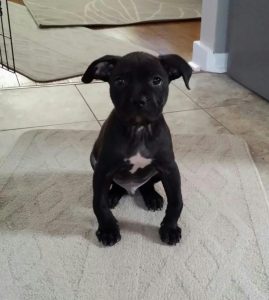
Knuckling is generally a neurological problem that can be seen in just one paw, two paws, three paws or all four paws. This condition can affect any dog no matter the age, breed or size.
The common reasons for this knuckling may include:
- Weakness
- Sore paws
- Radial nerve damage
- Intervertebral disc disease
- Carpal flexural deformity
- Fibrocartilaginous embolism
- Degenerative myelopathy
- Tumour
- Carpal hyperextension
Muscle Weakness
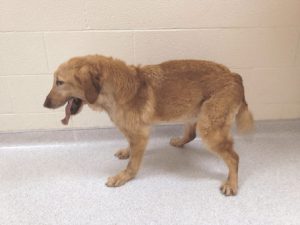
When your dog is very sick or old, it is very likely to lose muscle mass as a result of arthritis and inflammation. In some cases, medications containing steroids can cause loss of muscle mass in dogs. In some cases, atrophy of the nerves are affected and they become smaller and weaker.
Also, injuries that prevent your pooch from moving around as normal are very likely to cause weakness. In all of these cases, your dog may be seen dragging its rear paws – this is your dog knuckling.
Sore Paws
If you notice that knuckling started happening suddenly, it’s advisable to check your doggie’s paws as they may be a sharp object such as a thorn embedded in their paw which can cause pain as they are walking. Your pooch may also have a red irritated paw caused by an allergy, broken toes, bug bite or laceration from any other source.
Another possible cause of sore paws is, a burn from hot pavement or a toxic chemical…this can cause your dog to avoid putting pressure on their paw as they walk, so they walk with their paw turned over.
If you notice anything like this with your dog, quickly bring your pet to the vet if the issue does not resolve within a day, as some objects can cause infections if not taken out and treated appropriately.
Radial Nerve Damage
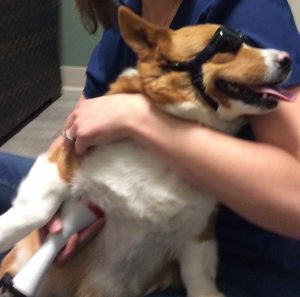
Your dog’s radial nerve is the largest in the front leg and is responsible for extending the elbow, wrist, and toes.
When its radial nerve is injured, perhaps by trauma to the leg, a lesion on the leg or cancer, paralysis of the front leg can occur leading to knuckling.
Intervertebral Disc Disease
This disease occurs when the disc in your dog’s spinal cord starts to deteriorate. It is generally a result of age but can also occur in younger dogs due to physical trauma or strenuous activity.
Also, accidents like getting hit by a car or fighting with another animal can bring on intervertebral disc disease.
The symptoms can vary but in general, the dog will begin stumbling, knuckling their paws, showing stiffness and holding their head low, sensitivity to touch and movement, arching their back, showing lameness, weakness, an unwillingness to move, shaking, loss of coordination and collapsing, potentially paralysis on one or more limbs and overall walking oddly.
In mild cases, prescribed steroids and anti-inflammatories can help treat this condition, but in severe cases, surgery may be needed.
Some breeds that are predisposed due to a disorder of cartilage formation, called chondrodystrophy, are Bulldogs, Basset Hounds, Dachshunds, Corgis, Beagles, Cocker Spaniels, Shih-Tzus, Poodles and Pekingese.
Other breeds that are commonly affected not due to chondrodystrophy are German Shepherds, Doberman Pinschers and Labrador Retrievers. And also dogs who are of these breeds, and obese are at a higher risk of intervertebral disc disease.
Carpal Flexural Deformity
This can occur in puppies as they go through growth spurts. Any dog can develop carpal flexural deformity, although it is commonly seen in larger breeds, sometimes caused by an excess of protein.
Your Vet can assist you in determining the correct diet for your pet. Generally, if your puppy is under 4 months of age, it may show signs of over flexing or bulging its wrists forward, leading to knuckling.
In most cases, your dog’s wrists will straighten out on their own within a few weeks and will not require treatment but using a splint may be wise as your dog could develop a lifelong deformity.
Fibrocartilaginous Embolism
This is a spinal condition that can be seen in any dog but is more commonly found in larger breeds.
The main cause of fibrocartilaginous embolism is exercise trauma, which can cause a piece of your pup’s intervertebral disc to detach and end up in a blood vessel. This can lead to a blood clot or an embolism, which cuts off the supply of blood and oxygen to the neurons in a part of the spinal cord and can cause them to die, which leads to knuckling.
Your dog may likely develop fibrocartilaginous embolism while exercising, it may yelp once, but will most likely show no further signs of pain. Afterwards, it then loses functionality of one or several limbs without much warning.
Dogs with this condition may or may not see improvements but will rarely experience any worsening of the symptoms.
Degenerative Myelopathy
Your older dog who begins knuckling can be lame, experiencing arthritis or developing degenerative myelopathy. Degenerative myelopathy occurs when there is a loss of white matter that is sheathing the spinal cord, also known as myelin.
Your dog will most likely develop this disease between the ages of 8 to 14 years and the sign will begin with a loss of coordination in the hind limbs. Your dog will start wobbling, dragging its feet and its rear paws will knuckle over often when they are attempting to turn.
Some other symptoms of this disease include your pooch falling frequently and showing difficulty when getting up.
This disease is not painful but is progressive and can continue to get worse. Also, it can take 6 months to 1 year for the disease to progress until the point that your dog is unable to walk.
Tumor
Tumors that interfere with nerves often press on the spinal cord or otherwise affect the extremities or brain. This is a likely cause of paw knuckling in your dog.
Carpal Hyperextension
Carpal hyperextension is seen mostly in large to giant breed puppies. This condition is normally noticed in the growth plate of your dog’s front leg, either in the wrist or carpal area.
It happens when the part of the dog’s body that bears weight is not able to support his entire body and this causes your pooch to walk with its entire paw on the ground. These causes can range from minor to serious, so when you notice knuckling in your pup, you should take your pup to get checked by your vet immediately.
Some of the illnesses can be serious and, in some cases, fatal, whereas others can improve with time. Most of these illnesses, aside from degenerative myelopathy, have positive outcomes with satisfactory recoveries, as long as they are treated promptly and properly.
Treatment Options for Knuckling in Dogs
Ideally, dogs with sore paws due to cuts or scratches would rest to allow it to heal. However, dogs are active and will often continue to move around and therefore their wound may reopen. If the cut seems deep, your dog should be taken to the vet immediately. But if it is a regular scratch, you should examine its paw and look out for broken nails, which can also be a source of bleeding. The wound should then be washed with warm water and any debris should be removed using tweezers or dislodged by soaking the affected paw in a bowl of warm water. Additionally, the area should be cleaned with a diluted antiseptic and antiseptic cream should be applied.
You can also wrap the paw in gauze to provide soft cushioning, followed by a pressure bandage. The bandage should cover the wrist joint but should leave out the front toes, and should not be too tight. Remove the bandage after three days but keep your dog from reopening the wound by using a dog boot when they go out.
If there is excessive oozing or bleeding, sores on the pads, toenails with crusting at the base, thick skin or deep cracks, please contact your vet.
In cases where intervertebral disc disease is diagnosed or suspected, treatments ranging from rest and medical management to surgery may be needed, depending on the severity. The priority will be to manage the inflammation and pain your dog is feeling.
Veterinarian’s Advice
Your veterinarian may suggest either nonsteroidal anti-inflammatory medications, corticosteroids, narcotics, muscle relaxants or other medications along with restricted movement and rest. If these drugs do not alleviate the pain, surgery may be required. Three to six weeks of consistent cage confinement is essential for a full recovery in all cases.
Your pooch should be placed on a soft surface and will need to be turned every few hours in order to prevent pressure sores from developing. If your dog is overweight, it will most likely be put on a dietary program.
Other techniques, such as massage therapy, acupressure or acupuncture, supplements and other supportive care can also be beneficial.
If your puppy is knuckling as a result of carpal flexural deformity, stop feeding them milk and meat as high protein can worsen the condition.
Diagnosing fibrocartilaginous Embolism
A case like fibrocartilaginous embolism will require an MRI to be diagnosed. CT scans and spinal radiographs can also be beneficial. This condition is not easily treated, and recovery will usually rely on time for the spinal cord to create new blood vessels or open up the ones that were affected.
While recovering, your pup should be resting on a soft bed and its position changed every few hours. Physical therapy can help in the recovery phase, along with acupuncture, laser therapy and hyperbaric oxygen therapy. In most cases, your dog will be able to walk in 2 to 6 weeks.
The horrible Degenerative myelopathy is diagnosed by a process of elimination. Diagnostic tests and MRIs will be used to look for other sources of the symptoms, and once ruled out, it will be decided that your pet has degenerative myelopathy.
Sadly, this illness does not have any known treatments or ways of slowing the progression. However, your dog’s quality of life can be improved by nursing care, prevention of pressure sores, monitoring for urinary tract infections, using carts and harnesses to facilitate mobility, and physical rehabilitation.
How to Prevent Knuckling in Dogs
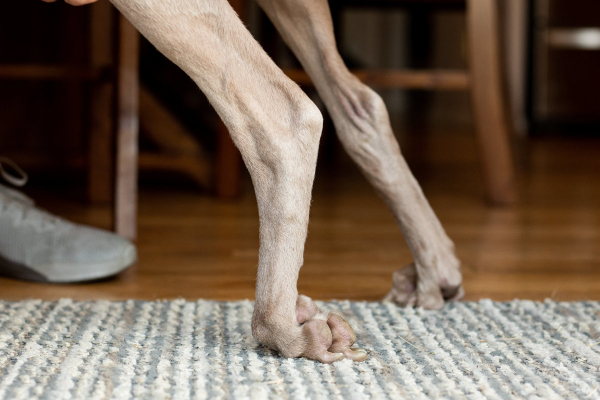
To keep your dog from developing a condition that leads to knuckling (like Intervertebral Disc Disease), keep its activity and exercise levels under control. This means that you should not allow your pooch to run or jump excessively.
If your dog is predisposed, do not let it leap off of high surfaces, and no matter what you do, make sure obesity is avoided. Your dog’s foot pads need protection from the heat and cold, as they can burn on hot pavement and can get irritated by the ice and salt in the wintertime.
So, in this case, dog boots are a good way to prevent sore paws during the hot and cold months. A special foot wax is another option to protect your doggie’s delicate paws. Also keep your pet’s hair around the paws short, as it will help keep out objects like grass seeds. It will help you to see any objects that are stuck in your dog’s paws.
If your puppy is knuckling and has a carpal flexural deformity, keep them calm and away from any activity that will challenge their mobility, including going up and down stairs frequently, until they are fully recovered.
Carpal flexural deformity can be prevented by properly weaning puppies before separating them from their mothers. Finally, it’s important to let puppies out in places they can run, dig, and use their muscles properly.
If you decide to use a splint, put it on in the afternoon or before your puppy falls asleep so that they wont pay too much attention to it.
Training Socks for Knuckling in Dogs
-
Product on sale
 Walkin’ Rear No-knuckling Training Sock$65.00 – $89.00
Walkin’ Rear No-knuckling Training Sock$65.00 – $89.00
You may find training socks helpful as a corrective measure for knuckling in dogs. Also braces and other similar devices can also be useful. This is a temporary training tool for short-term, multiple uses to help correct gait and improve hind paw placement.
Here are the reasons why Training Socks will help your doggie’s knuckling problem.
- It provides training support for dogs who drag their back paws.
- Stimulates your dog between its toes and causes him to pick the foot up higher.
- Designed to enhance proprioception.
- Helps your dog’s legs carry its body weight better.
- Perfect for rehabilitative use if your dog is recovering from spinal surgery.
- Lightweight, comfortable, and adjustable, with convenient touch-fastener closures.
Training socks are best used on dogs for two to five-minute walks and removed in between.
Many dog parents have shared their great success with training socks.
It’s important to note that this is a training tool and will not cure the condition that your pet has.
It’s intended to train them to lift their paw higher to decrease dragging. It is only meant to be used for 3-5 minutes per session.
It’s also very important to ask your veterinarian to see if the training socks would be ideal for your dog’s condition because these socks aren’t recommended in all cases of knuckling in dogs.
 Total Pooch Dog Supplements, Tear Stain Removers, De-wormers, Tylosin for Dogs and other great products.
Total Pooch Dog Supplements, Tear Stain Removers, De-wormers, Tylosin for Dogs and other great products.
